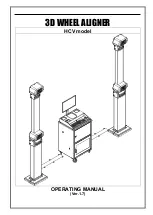
Käyttöohje
User’s manual
8.2. Imbalance hasn’t been measured
The optimization can be done directly if the wheel hasn’t been balanced yet. Turn on the machine and press
[OPT]. The left display will say OPT. Rotate the wheel, and as the rotation is completed, follow the instructions
given in chapter 8.1. Press [SET] to exit the function.
9. Self-calibration of the machine
The machine has been calibrated in the factory, but the system’s parameters may have changed during long
periods of transportation and use, which can cause the machine to operate incorrectly. That is why the machine is
equipped with self-calibration feature, which allows the user to ensure the correct operation of the machine after
such situations.
After the machine has been powered up and has finished initialization, install a middle sized rim on which a wheel
weight can be attached to the machine. Follow the instructions in chapter 7.2. to input the rim’s data.
Press [FINE] + [SET] keys (Fig 24) and rotate the wheel manually until the display turns blank, and move your
hands away from the wheel. If the display says “REDUCE”, it means that the rotation speed is too high. If the
rotation speed is normal, the display will say “RIN ---“. When the display says “STOP”, the wheel will stop
rotating and the display will look like fig 21. Press the [SET] key to exit.
Attach the 100 gram wheel weight to any position on the outer edge of the rim (Fig 25) and rotate the wheel
manually until the display turns blank. Take your hands off the wheel to move to the next stage, or press the [SET]
key to exit.
After the rotation stops, the calibration has been completer (Fig 26). The machine is now ready to be used.
NOTE:
When self-calibrating, the input data of the wheel must be correct, and the 100 gram calibration weight
must weigh the correct amount, otherwise the self-calibration will fail and the accuracy of the machine’s
measuring will be weakened.
[42]
Fig 24
Fig 25
Fig 26
























